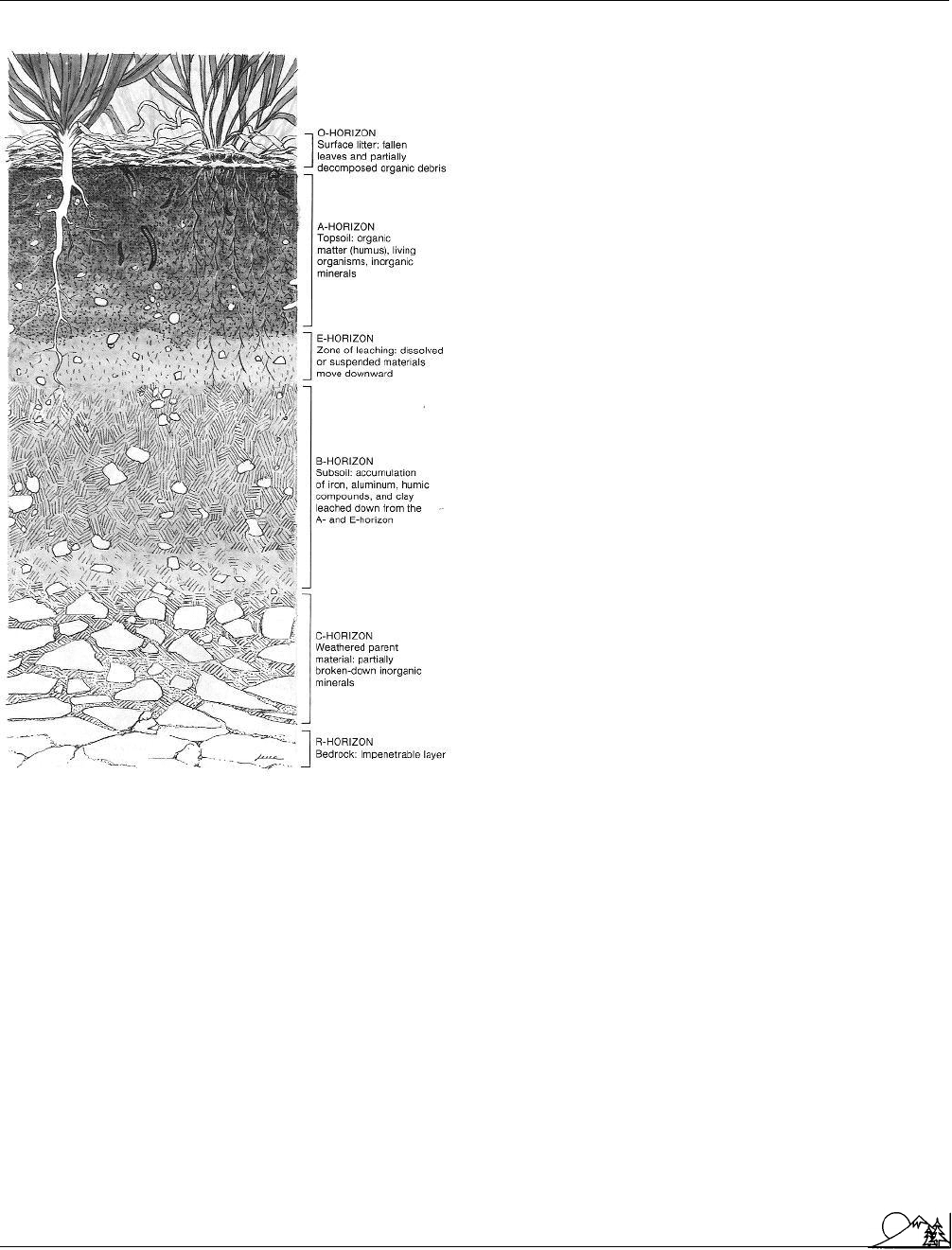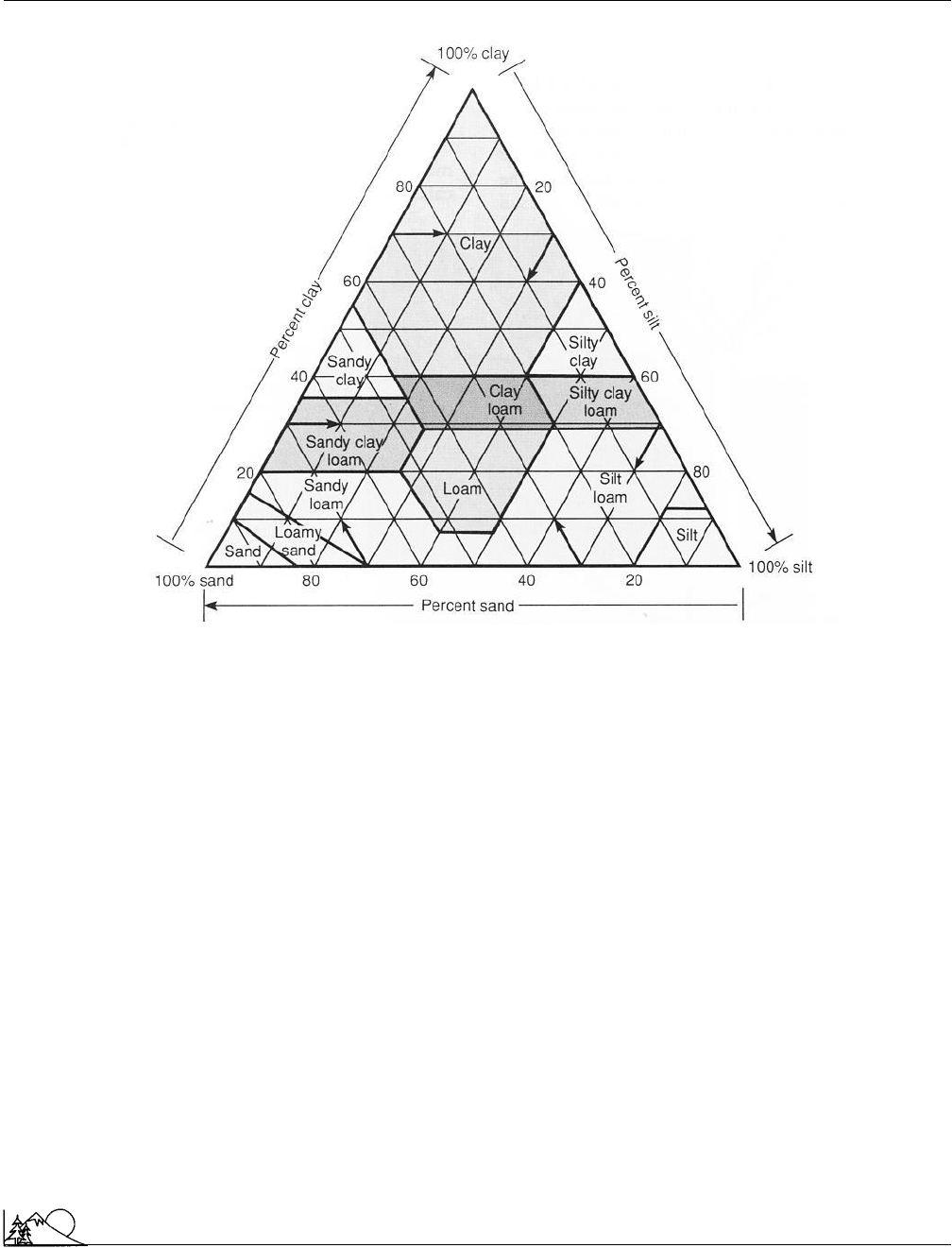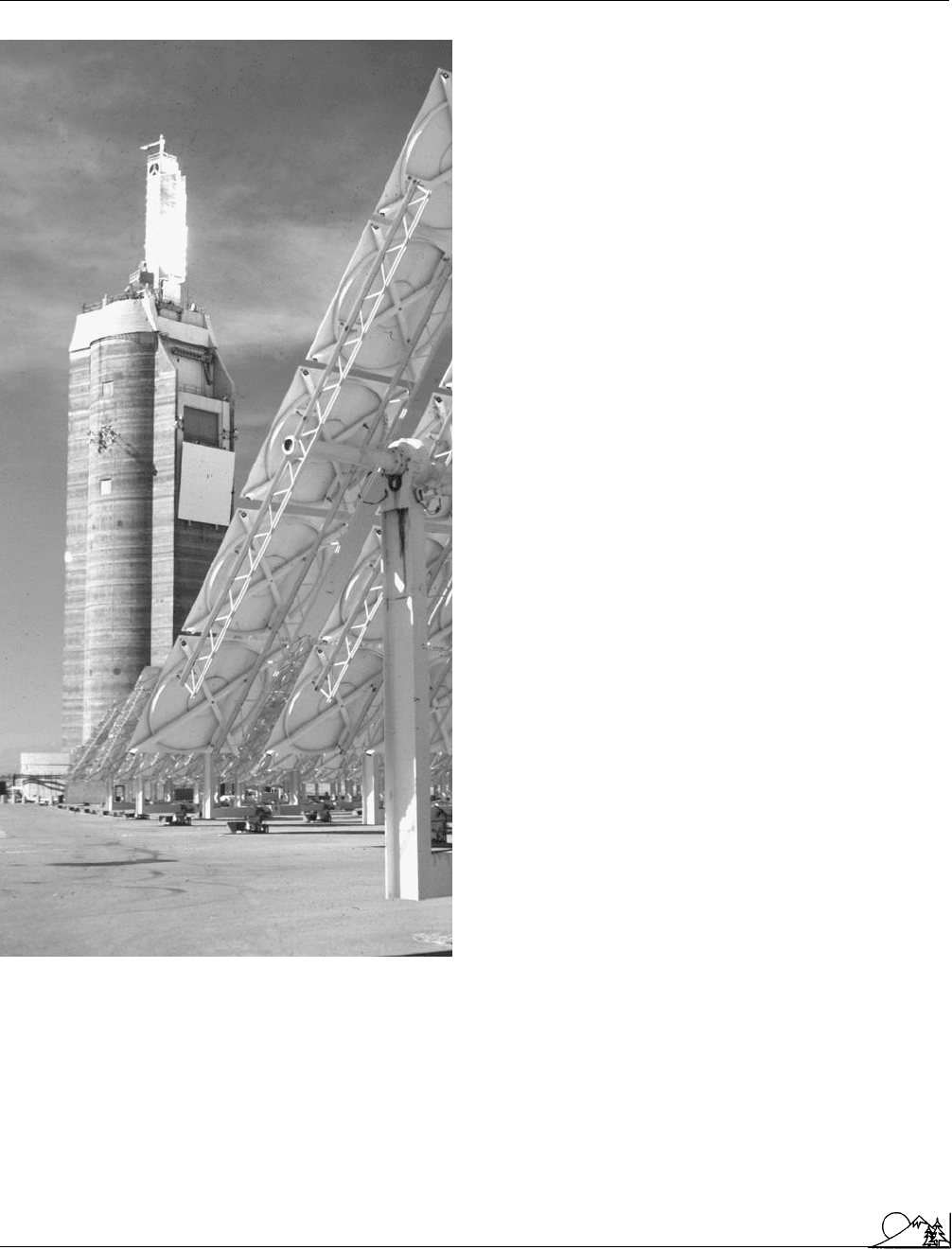Environmental Encyclopedia
Подождите немного. Документ загружается.


Environmental Encyclopedia 3
Soil profile
P
ERIODICALS
Helms, D. “Conserving the Plains: The Soil Conservation Service in the
Great Plains.” Agricultural History 64 (Spring 1990): 58–73+.
Soil consistency
The manifestations of the forces of cohesion and adhesion
acting within the
soil
at various water contents, as expressed
by the relative ease with which a soil can be deformed or
ruptured. Consistency states are described by terms such as
friable, soft, hard, or very hard. These states are assessed
by thumb and thumbnail penetrability and indentability, or
more quantitatively, by Atterberg limits, which consist of
liquid limit, plastic limit, and plasticity number. Atterberg
limits are usually determined in the laboratory and are ex-
pressed numerically. See also Soil compaction; Soil conserva-
tion; Soil texture
Soil, contaminated
see
Contaminated soil
Soil eluviation
When water moves through the
soil
, it also moves small
colloidal-sized materials. This movement or
leaching
of
materials like clay, iron, or calcium carbonate is called eluvia-
tion. The area where the materials have been removed is
the zone of eluviation and is called the E
horizon
. Zones
of eluviation contain fewer nutrients for plant growth. E
horizons are often found in forested soils.
Soil illuviation
When water moves through the
soil
, it moves small colloi-
dal-sized particles with it. These particles of clay, iron,
hu-
mus
, and calcium carbonate will be deposited in zones below
the surface or in the
subsoil
. The zones are called illuvial
zones and the process is referred to as illuviation. Illuvial
zones are most often referred to as B horizons, and the
subscript with the B designates the kind of material translo-
cated (i.e., B
t
= clay accumulation).
Soil liner
One of the requirements of modern sanitary landfills is that
a
soil
liner be placed on top of the existing soil. Liners are
needed to prevent the penetration of
landfill
leachate into
the soil. Without a liner, leachate could move through the
1317
soil and contaminate the
groundwater
. Soil liners can be
made of clay, plastic,
rubber
, blacktop, or concrete.
Soil loss tolerance
Soil
loss tolerance is the maximum average annual soil re-
moval by
erosion
that will allow continuous cropping and
maintain soil productivity (T). It is occasionally defined as
the maximum amount of soil erosion offset by the maximum
amount of soil development while maintaining an equilib-
rium between soil losses and gains. T is usually expressed
in terms of tons per acre or tons per hectare. Because T
values are difficult to quantify, they are usually inferred by
human judgment rather than scientific analysis. In determin-
ing T values, the depth of the soil to consolidated material
or depth to an unfavorable
subsoil
is considered. T values
are an expression of concern for plant growth but may not
adequately reflect environmental concerns.
Soil organic matter
Additions of plant debris to soils will initiate the build up
of organisms that will decompose the plant debris. After
decomposition
the organic material will be called organic
matter or
soil humus
. This decomposed plant debris will
be in the form of very small particles and will coat the sand,
silt
, and clay particles making up the mineral soil particles,
thus making the soil black. The more organic matter accu-
mulating in a soil, the darker the soil will become. Continued
additions of organic matter are important to create a soft,
tillable soil that is conducive to plant growth. Organic matter
is important in soils because it will add nutrients, store
nitrogen
and other positive cations, and create a stronger
soil aggregate that will withstand the impact of raindrops
and thus prevent water
erosion
.
Soil profile
The layers in the
soil
from the surface to the
subsoil
. The
soil profile is the collection of soil
horizons
. Soil profiles
will vary from location to location because of the five soil-
forming factors:
climate
, vegetation,
topography
, soil par-
ent material, and the length of time the soil has been
weath-
ering
. By looking at a soil’s profile many interpretations can
be made about
land use
and the suitability of the soil for
a specific use.
Soil, saline
see
Saline soil

Environmental Encyclopedia 3
Soil survey
A soil profile showing the horizons in a cross-
section of soil. (McGraw-Hill Inc. Reproduced by per-
mission.)
Soil survey
A
soil
survey is a combination of field and laboratory activi-
ties intended to identify the basic physical and chemical
properties of soils, establish the distribution of those soils
at specific map scales, and interpret the information for a
variety of uses.
There are two kinds of soil surveys, general purpose
and specific use. General purpose surveys collect and
display data on a wide range of soil properties which can
be used to evaluate the suitability of the soil or area for
a variety of purposes. Specific use soil surveys evaluate
the suitability of the land for one specific use. Only
1318
physical and chemical data related to that particular use
are collected, and map units are designed to convey that
specific suitability.
A soil survey consists of three major activities: research,
mapping, and interpretation. The research phase involves
investigations that relate to the distribution and performance
of soil; during the mapping phase, the land is actually walked
and the soil distribution is noted on a map base which is
reproducible. Interpretation involves the evaluation of the
soil distribution and performance data to provide assess-
ments of soil suitability for different kinds of
land use
.
During the research phase of the survey, soil scientists
first establish which soil properties are important for that
type of survey. They then establish field relationships be-
tween soil properties and landscape features and determine
the types of soils to be mapped, preparing a map legend.
In this phase, scientists also evaluate land productivity and
recommend management practices as they relate to the map-
ping units proposed in the map legend.
Mapping is perhaps the most widely recognized phase
of a soil survey. It is conducted by evaluating and delineating
the soils in the field at a specified map intensity or scale.
Soil profile
observations are made at three levels of detail.
Representative profiles are taken from soil pits, generally
with laboratory corroboration of the observations made by
soil scientists. Intermediate profiles are taken from soil pits,
roadside excavations, pipelines or other chance exposures,
and some sampling and description does occur at this level.
Soil-type identifications are taken from auger holes or small
pits, and only brief descriptions are made without laboratory
confirmation.
With information gathered from sampling, as well
as from the earlier research phase, soil scientists draw soil
boundaries on an aerial photograph. These delineations or
map units are systematically checked by field transects—
straight-line traverses across the landscape with samples
taken at specified intervals to confirm the map-unit compo-
sition.
Field research and the process of mapping produce a
range of information that requires interpretation. Interpreta-
tions can include discussions of land use potential, manage-
ment practices, avoidance of hazards, and economic evalua-
tions of soil data. The interpretation of the information
gained during a soil survey is based on crop yield estimates
and soil response to specific management. Crop yields are
estimated in the following ways: by comparison with data
from experimental sites on identified soil types; by field
experiments conducted within the survey area; from farm
records, demonstration plots or other farm system studies;
and by comparison of known crop requirements with the
physical and chemical properties of soils. Soil response in-
volves the evaluation of how the soils will respond to changes

Environmental Encyclopedia 3
Solar constant cycle
Soil texture depends on the relative proportions of sand, silt and clay in a soil, as represented in this diagram.
(McGraw-Hill Inc. Reproduced by permission.)
in use or management, such as
irrigation
,
drainage
, and
land
reclamation
. Part of this evaluation includes an assess-
ment of hazards that may result from changes such as
ero-
sion
or
salinization
.
In general purpose surveys, which are the kind
conducted in the United States, soils are mapped according
to their properties on the hypothesis that soils which look
and feel alike will behave the same, while those that do
not will respond differently. A soil survey attempts to
delineate areas that behave differently or will respond
differently to some specified management, and the mapping
units provide the basis for locating and predicting these
differences. See also Contaminated soil; Soil conservation;
Soil Conservation Service; Soil texture; U. S. Department
of Agriculture
[James L. Anderson]
R
ESOURCES
B
OOKS
Dent, D., and A. Young. Soil Survey and Land Evaluation. Boston: Allen
and Unwin, 1981.
1319
Soil texture
The relative proportion of the mineral particles that make
up a
soil
or the percent of sand,
silt
, and clay found in a
soil. Texture is an important soil characteristic because it
influences water
infiltration
, water storage, amount of
aera-
tion
, ease of tilling the soil, ability to withstand a load, and
soil fertility. Textural names are given to soil based on the
percentage of sand, silt, and clay. For example, loam is a
soil with equal proportions of sand, silt, and clay. It is best
for growing most crops.
Solar cell
see
Photovoltaic cell
Solar constant cycle
The solar constant is a measure of the amount of radiant
energy reaching the earth’s outer
atmosphere
from the sun.

Environmental Encyclopedia 3
Solar detoxification
More precisely, it is equal to the rate at which solar radiation
falls on a unit area of a plane surface at the top of the
atmosphere and oriented at a perpendicular distance of 9.277
x10
7
mi (1.496 X 10
8
km) from the sun. That distance is
the average (mean) distance between earth and sun during
the course of a single year.
Measuring the solar constant has historically been a
difficult challenge since there were few good methods for
measuring energy levels at the top of the atmosphere. A
solution to this problem was made possible in 1980 with
the launching of the Solar Maximum (Solar Max) Mission
spacecraft. After repair by the Challenger astronauts in 1984,
Solar Max remained in orbit, taking measurements of solar
phenomena until 1989. As a result of the data provided by
Solar Max, the solar constant has now been determined to
be 1.96 calories per 0.3 in
2
(2 cm
2
) per minute, or 1,367
watts per 3.3 ft (1 m). This result confirms the value of 2.0
calories per cm
2
per minute long used by scientists.
In addition to obtaining a good value for the solar
constant, however, Solar Max made another interesting dis-
covery. The solar constant is not, after all, really constant.
It varies on a daily, weekly, monthly, and yearly basis, and
probably much longer. The variations in the solar constant
are not large, averaging at a few tenths of a percent.
Scientists have determined the cause of some variabil-
ity in the solar constant and are hypothesizing others. For
example, the presence of sunspots results in a decrease in
the solar constant of a few tenths of a percent. Sunspots are
regions on the sun’s surface where temperatures are signifi-
cantly lower than surrounding areas. Since the sun presents
a somewhat cooler face to the earth when sunspots are pres-
ent, a decrease in the solar constant is not surprising.
Other surface features on the sun also affect the solar
constant. Solar flares, for example, are outbursts or explo-
sions of energy on the surface that may last for many weeks.
Correlations have been made between the presence of solar
flares and the solar constant over the twenty-seven-day pe-
riod of the sun’s rotation.
A longer-lasting effect is caused by the eleven-year
sunspot cycle. As the number of sunspots increase during
the cycle, so does the solar constant. For some unknown
reason, this long-term effect is just the opposite of that
observed for single sunspots.
Scientists believe that historical studies of the solar
constant may provide some clues about changes in the earth’s
climate
. The nineteenth-century British astronomer E.
Walter Maunder pointed out that sunspots were essentially
absent during the period of 1645 to 1715, a period now called
the Maunder minimum. The earth’s climate experienced a
dramatic change at about the same time, with temperatures
dropping to record lows. These changes are now known as
the Little
Ice Age
. It seems possible that further study of
1320
the solar constant cycle may explain the connection between
these two phenomena.
[David E. Newton]
R
ESOURCES
B
OOKS
Chorlton, Windsor, and the editors of Time-Life Books. Ice Ages. Alexan-
dria, VA: Time-Life Books, 1983.
Hudson, Hugh S. “Solar Constant.” In McGraw-Hill Encyclopedia of Sci-
ence & Technology. 7th ed. New York: McGraw-Hill, 1992.
Solar detoxification
Solar energy
is being investigated as a potential means to
destroy environmental contaminants. In solar
detoxifica-
tion
, photons in sunlight are used to break down contami-
nants into harmless or more easily treatable products. Solar
detoxification is a “destructive” technology—it destroys con-
taminants as opposed to “transfer-of-phase” technologies
such as activated
carbon
or air stripping, which are more
commonly used to remove contaminants from the
envi-
ronment
.
In a typical photocatalytic process, water or
soil
con-
taining organic contaminants is exposed to sunlight in the
presence of a catalyst such as titanium dioxide or humic and
fulvic acids. The catalyst absorbs the high energy photons,
and oxygen collects on the catalyst surface, resulting in the
formation of reactive
chemicals
referred to as hydroxyl free-
radicals and atomic oxygen (singlet oxygen). These reactive
chemicals transform the organic contaminants into degrada-
tion products, such as
carbon dioxide
and water. Solar
detoxification can be accomplished using natural sunlight or
by using inside solar simulators or outside solar concentra-
tors, both of which can concentrate light 20 times or more.
The effectiveness of solar detoxification in both water and
soil is affected by
sorption
of the toxic compounds on sedi-
ments or soil and the depth of light penetration. Solar detoxi-
fication of volatilized toxic compounds may also occur natu-
rally in the
atmosphere
.
For solar detoxification to be successfully accom-
plished, toxic chemicals should be converted to thermody-
namically stable, non-toxic end products. For example, chlo-
rinated compounds should be transformed to carbon dioxide,
water, and hydrochloric
acid
through the general sequence:
organic pollutants → aldehydes → carboxylic acids →
carbon dioxide
Photocatalytic degradation such as this usually results
in complete mineralization only after prolonged irradiation.
If intermediates formed in the degradation pathway are non-
toxic, however, the reaction does not have to be driven
completely to carbon dioxide and water for acceptable detox-

Environmental Encyclopedia 3
Solar energy
ification to have occurred. In the solar detoxification of
pentachlorophenol
(PCP) and 2,4-dichlorophenol, for ex-
ample, toxic intermediates were detected; however, with ex-
tended exposure to sunlight, the compounds were rendered
completely nontoxic, as measured by
respiration
rate mea-
surements in
activated sludge
.
Many applications of solar detoxification implemented
at ambient temperatures have only 90–99% efficiency and
do not completely mineralize the compounds. The rate of
some photolytic reactions can be increased by raising the
temperature of the reaction system, but the production of
stable reaction intermediates (some of which may be toxic)
is reduced. The changes in reaction rate have been attributed
to a combination of a thermally induced increase in the
photon-absorption rate, an increase in the quantum yield of
the primary photoreaction, and the initiation of photoin-
duced radical-chain reactions.
Research conducted at the Solar Energy Research In-
stitute (SERI), a laboratory funded by the
U.S. Department
of Energy
, has demonstrated that
chlorinated hydrocar-
bons
, such as trichloroethylene (TCE), trichloroethane
(TCA), and
vinyl chloride
, are vulnerable to photocatalytic
treatment. Other toxic chemicals shown to be degraded by
solar detoxification include a textile dye (Direct Red No.
79), pinkwater, a munitions production waste, and many
types of pesticides, including chlorinated cyclodiene insecti-
cides, triazines, ureas, and dinitroaniline herbicides. In con-
junction with
ozone
and
hydrogen
peroxide, both of which
are strong oxidants, ultraviolet light has been shown to be
effective in oxidizing some refractory chemicals such as
methyl ethyl ketone, a degreaser, and
polychlorinated bi-
phenyls
(PCBs). See also Oxidizing agent
[Judith Sims]
R
ESOURCES
B
OOKS
Mill, T., and W. Mabey. “Photodegradation in Water.” In Environmental
Exposure from Chemicals, edited by W. B. Neely and G. E. Blau. CRC
Press, Boca Raton, FL: 1985.
P
ERIODICALS
Al-Ekabi, H., et al. “Advanced Technology for Water Purification by
Heterogenous Photocatalysis.” International Journal of Environment and
Pollution 1, nos. 1–2 (1991): 125–136.
Manilai, V. B., et al. “Photocatalytic Treatment of Toxic Organics in
Wastewater: Toxicity of Photodegradation Products.” Water Research 26,
no. 8 (1992): 1035–1038.
Stephenson, F. A. “Chemical Oxidizers Treat Wastewater.” Environmental
Protection 3, no. 10 (1992): 23–27.
O
THER
Solar Energy Research Institute, Development and Communications Of-
fice. Solar Treatment of Contaminated Water. SERI/SP-220-3517. Goldon,
CO: Solar Heat Research Division, Solar Energy Research Institute, 1989.
1321
Solar energy
The sun is a powerful fusion reactor, where
hydrogen
atoms
fuse to form helium and give off a tremendous amount of
energy. The surface of the sun, also known as the photo-
sphere, has a temperature of 6,000 K (10,000°F [5,538°C]).
The temperature at the core, the region of
nuclear fusion
,
is 36,000,000°F (20,000,000°C). A ball of
coal
the size of
the sun would burn up completely in 3,000 years, yet the
sun has already been burning for three billion years and is
expected to burn for another four billion. The power emitted
by the sun is 3.9 x 10
26
watts.
Only a very small fraction of the sun’s radiant energy,
or insolation, reaches the earth’s
atmosphere
, and only
about half of that reaches the surface of the earth. The other
half is either reflected back into space by clouds and ice or
is absorbed or scattered by molecules within the atmosphere.
The sun’s energy travels 93,000,000 mi (149,667,000 km)
to reach the earth’s surface. It arrives about 8.5 minutes after
leaving the photosphere in various forms of radiant energy
with different wave lengths, known as the electromagnetic
spectrum.
Solar radiation, also known as solar flux, is measured
in Langleys per minute. One Langley equals one calorie
of radiant energy per square centimeter. It is possible to
appreciate the magnitude of the energy produced by the sun
by comparing it to the total energy produced on earth each
year by all sources. The annual energy output of the entire
world is equivalent to the amount the sun produces in about
five billionths of a second. Solar radiation over the United
States each year is equal to 500 times its energy consumption.
The solar energy that reaches the surface of the earth
and enters the biological cycle through
photosynthesis
is
responsible for all forms of life, as well as all deposits of
fossil fuel. All energy on earth comes from the sun, and it
can be utilized directly or indirectly. Direct uses include
passive solar systems such as greenhouses and atriums, as
well as windmills, hydropower, and the burning of
biomass
.
Indirect uses of solar energy include photovoltaic cells, in
which semiconductor crystals convert sunlight into electrical
power, and a process that produces methyl alcohol from
plants.
Wind results from the uneven heating of the earth’s
atmosphere. About 2% of the solar energy which reaches
the earth is used to move air masses, and at any one time
the kinetic energy in the wind is equivalent to 20 times the
current electricity use. Due to mechanical losses and other
factors, windmills cannot extract all this power. The power
produced by a windmill depends on the speed of the wind
and the effective surface areas of the blades, and the maxi-
mum extractable power is about 60%.

Environmental Encyclopedia 3
Solar energy
A solar furnace in Albuquerque, New Mexico.
(Photograph by Mark Antman. Phototake. Reproduced by
permission.)
The use of the water wheel preceded windmills, and
it may be the most ancient technology for utilizing solar
energy. The sun causes water to evaporate, clouds form
upon cooling, and the subsequent precipitation can be stored
behind
dams
. This water is of high potential energy, and
1322
it is used to run water wheels or turbines. Modern turbines
that run electric generators are approximately 90% efficient,
and in 1998 hydroelectric energy produced about 4% of the
primary energy used in the United States.
A passive solar heating system absorbs the radiation
of the sun directly, without moving parts such as pumps.
This kind of low-temperature heat is used for space heating.
Solar radiation may be collected by the use of south-facing
windows in the Northern Hemisphere. Glass is transparent
to visible light, allowing long-wave visible rays to enter, and
it hinders the escape of long-wave heat, therefore raising
the temperature of a building or a greenhouse.
A thermal mass such as rocks, brine, or a concrete floor
stores the collected solar energy as heat and then releases it
slowly when the surrounding temperature drops. In addition
to collecting and storing solar energy as heat, passive systems
must be designed to reduce both heat loss in cold weather
and heat gain in hot weather. Reductions in heat transfer
can be accomplished by heavy insulation, by the use of double
glazed windows, and by the construction of an earth brim
around the building. In hot summer weather, passive cooling
can be provided by building extended overhangs or by plant-
ing deciduous trees. In dry areas such as in the southwestern
United States or the Mediterranean, solar-driven fans or
evaporative coolers can remove a great deal of interior heat.
Examples of passive solar heating include roof-mounted hot-
water heaters, solarian glass-walled rooms or patios, and
earth-sheltered houses with windows facing south.
A simple and innovative technology in passive systems
is a design based on the fact that at depth of 15 ft (4.6 m)
the temperature of the earth remains at about 55°F (13°C)
all year in a cold northern
climate
and about 67°F (19°C)
in warm a southern climate. By constructing air intake tubes
at depths of 15 ft, the air can be either cooled or heated
to reach the earth’s temperature, proving an efficient air
conditioning system.
Active solar systems differ from passive systems in that
they include machinery, such as pumps or electric fans, which
lowers the net energy yield. The most common type of active
systems are photovoltaic cells, which convert sunlight into
direct current electricity. The thin cells are made from semi-
conductor material, mainly silicon, with small amounts of
gallium arsenide or
cadmium
sulfide added so that the cell
emits electrons when exposed to sunlight. Solar cells are
connected in a series and framed on a rigid background.
These modules are used to charge storage batteries aboard
boats, operate lighthouses, and supply power for emergency
telephones on highways. They are also used in remote areas
not connected to a power supply grid for pumping water
either for cattle or
irrigation
.
Both passive and active solar systems can be installed
without much technical knowledge. Neither produces
air

Environmental Encyclopedia 3
Solid waste
pollution
, and both have a very low environmental impact.
But a well-designed passive system is cheaper than active
one and does not require as much operative maintenance. See
also Alternative energy sources; Energy and the environment;
Energy policy; Passive solar design
[Douglas Smith]
R
ESOURCES
B
OOKS
Balcomb, J. D. Passive Solar Building. Cambridge: MIT Press, 1992.
Hedger, J. Solar Energy–The Sleeping Giant: Basics of Solar Energy. Deming:
Akela West Publishers, 1993.
P
ERIODICALS
Brown, L. R., et al. “A World Fit to Live In.” UNESCO Courier (November
1991): 28–31.
Peck, L. “Here Comes the Sun.” Amicus Journal 12 (Spring 1990): 27–32.
Solar Energy Research, Development
and Demonstration Act (1974)
Following the outbreak of the Arab-Israeli war in 1973,
Arab oil-producing states imposed an embargo on oil exports
to the United States. The embargo lasted from October
1973 to March 1974, and the long gas lines it caused high-
lighted the United States’ dependence on foreign
petro-
leum
. Congress responded by enacting the
Solar Energy
Research, Development and Demonstration Act of 1974.
The act stated that it was henceforth the policy of the
federal government to “pursue a vigorous and viable program
of research and resource assessment of solar energy as a
major source of energy for our national needs.” The act’s
scope embraced all energy sources which are renewable by
the sun—including solar thermal energy, photovoltaic en-
ergy, and energy derived from wind, sea thermal gradients,
and
photosynthesis
. To achieve its goals, the act established
two programs: the Solar Energy Coordination and Manage-
ment Project and the Solar Energy Research Institute.
The Solar Energy Coordination and Management
Project consisted of six members, five of whom were drawn
from other federal agencies, including the National Science
Foundation, the Department of Housing and Urban Devel-
opment, the
Federal Power Commission
, NASA, and the
Atomic Energy Commission
. Congress intended that the
project would coordinate national solar energy research, de-
velopment, and demonstration projects, and would survey
resources and technologies available for solar energy produc-
tion. This information was to be placed in a Solar Energy
Information Data Bank and made available to those involved
in solar energy development.
1323
Over the decade following the passage of the act in
1974, the United States government spent $4 billion on
research in solar and other
renewable energy
technologies.
During the same period, the government spent an additional
$2 billion on tax incentives to promote these alternatives.
According to a
U.S. Department of Energy
report issued
in 1985, these efforts displaced petroleum worth an esti-
mated $36 billion.
Despite the promise of solar energy in the 1970s and
the fear of reliance on foreign petroleum, spending on renew-
able energy sources in the United States declined dramati-
cally during the 1980s. Several factors combined during that
decade to weaken the federal government’s commitment to
solar power, including the availability of inexpensive petro-
leum and the skeptical attitudes of the Reagan and Bush
administrations, which were distrustful of government-
sponsored initiatives and concerned about government
spending.
To carry out the research and development initiatives
of the Solar Energy Coordination and Management Project,
the act also established the Solar Energy Research Institute,
located in Golden, Colorado. In 1991, the Solar Energy
Research Institute was renamed the National Renewable
Energy Laboratory and made a part of the national laboratory
system. The laboratory continues to conduct research in the
production of solar energy and energy from other renewable
sources. In addition, the laboratory studies applications of
solar energy. For example, it has worked on a project using
solar energy to detoxify
soil
contaminated with hazardous
wastes.
[L. Carol Ritchie]
R
ESOURCES
P
ERIODICALS
“Federal R&D Funding for Solar Technologies.” Solar Industry Journal
(First Quarter 1992).
“Photovoltaics.” Solar Industry Journal (First Quarter 1992).
O
THER
Solar Energy Research, Development, and Demonstration Act of 1974,
Pub. L. No. 93-473, 88 Stat. 1431 (1974), codified at 42 U.S.C. 5551, et
seq. (1988).
Solid waste
Solid waste is composed of a broad array of materials dis-
carded by households, businesses, industries, and agriculture.
The United States generates more than 11 billion tons (10
billion metric tons) of solid waste each year. The waste is
composed of 7.6 billion tons (6.9 billion metric) of industrial
nonhazardous waste, 2–3 billion tons (1.8–2.7 billion metric)
of oil and gas waste, over 1.4 billion tons (1.3 billion metric)

Environmental Encyclopedia 3
Solid waste
of mining waste, and 195 million tons (177 billion metric)
of
municipal solid waste
.
Not all solid waste is actually solid. Some semi-solid,
liquid, and gaseous wastes are included in the definition of
solid waste. The
Resource Conservation and Recovery
Act
(RCRA) defines solid waste to include
garbage
, refuse,
sludge
from municipal
sewage treatment
plants, ash from
solid waste incinerators, mining waste, waste from construc-
tion and demolition, and some hazardous wastes. Since the
definition is so broad, it is worth considering what the act
excludes from regulations concerning solid waste: untreated
sewage, industrial
wastewater
regulated by the
Clean
Water Act
,
irrigation
return flows, nuclear materials and
by-products, and hazardous wastes in large quantities.
RCRA defines and establishes regulatory authority for
hazardous waste
and solid waste. According to the act,
some hazardous waste may be disposed of in solid waste
facilities. These include hazardous wastes discarded from
households, such as paint, cleaning solvents, and batteries,
and small quantities of hazardous materials discarded by
business and industry. Some states have their own definitions
of solid waste which may vary somewhat from the federal
definition. Federal oversight of solid-waste management is
the responsibility of the
Environmental Protection Agency
(EPA).
Facilities for the disposal of solid waste include munic-
ipal and industrial landfills, industrial surface im-
poundments, and incinerators. Incinerators that recover en-
ergy as a by-product of waste
combustion
are called
resource recovery
or waste-to-energy facilities. Sewage
sludge and agricultural waste may be applied to land surfaces
as fertilizers or
soil
conditioners. Other types of
waste
management
practices include
composting
, most com-
monly of separated organic wastes, and
recycling
. Some
solid waste ends up in illegal open dumps.
Three quarters of industrial nonhazardous waste comes
from four industries: iron and steel manufacturers,
electric
utilities
, companies making industrial inorganic
chemicals
,
and firms producing
plastics
and resins. About one-third
of industrial nonhazardous waste is managed on the site
where it is generated, and the rest is transported to off-site
municipal or industrial waste facilities. Although surveys
conducted by some states are beginning to fill in the gaps,
there is still not enough landfills and surface impoundments
for industrial solid wastes. Available data suggest there is
limited use of environmental controls at those facilities, but
there is insufficient information to determine the extent of
pollution
they may have caused.
The materials in municipal solid waste (MSW) are
discarded from residential, commercial, institutional, and
industrial sources. The materials include plastics, paper,
glass, metals, wood, food, and
yard waste
; the amount of
1324
each material is evaluated by weight or volume. The distinc-
tion between weight and volume is important when consid-
ering such factors as
landfill
capacity. For example, plastics
account for only about 8% of MSW by weight, but more
than 21% by volume. Conversely, glass represents about 7%
of the weight and only 2% of the volume of MSW.
MSW has recently been the focus of much attention
in the United States. Americans generated 4.5 lb (2 kg) per
day of MSW in 2000, an increase from 4.3 lb (1.95 kg) per
day 1990, 4.0 lb (1.8 kg) per day in 1980, and 2.7 lb (1.2
kg) per day in 1960. This increase has been accompanied
by tightening federal regulations concerning the use and
construction of landfills. The expense of constructing new
landfills to meet these regulations, as well as frequently
strong public opposition to new sites for them, have sharply
limited the number of disposal options available, and the
result is what many consider to be a solid waste disposal
crisis. The much-publicized “garbage barge” from Islip, New
York, which roamed the oceans from port to port during
1987 looking for a place to unload, has become a symbol of
this crisis.
The disposal of MSW is only the most visible aspect
of the waste disposal crisis; there are increasingly limited
disposal options for all the solid waste generated in America.
In response to this crisis, the EPA introduced a waste man-
agement hierarchy in 1989. The hierarchy places source
reduction and recycling above
incineration
and landfilling
as the preferred options for managing solid waste.
Recycling diverts waste already created away from in-
cinerators and landfills. Source reduction, in contrast, de-
creases the amount of waste created. It is considered the
best waste management option, and the EPA defines it as
reducing the quantity and toxicity of waste through the
design, manufacture, and use of products. Source reduction
measures include reducing packaging in products, reusing
materials instead of throwing them away, and designing
products to be long lasting. Individuals can practice
waste
reduction
by the goods they choose to buy and how they
use these products once they bring them home. Many busi-
nesses and industries have established procedures for waste
reduction, and some have reduced waste toxicity by using
less toxic materials in products and packaging. Source reduc-
tion can be part of an overall industrial pollution prevention
and waste minimization strategy, including recapturing pro-
cess wastes for
reuse
rather than disposal.
Some solid wastes are potentially threatening to the
environment
if thrown away but can be valuable resources
if reused or recycled. Used motor oil is one example. It
contains
heavy metals
and other hazardous substances that
can contaminate
groundwater
, surface water, and soils.
One gallon (3.8 L) of used oil can contaminate 1 million
gal (3.8 million L) of water, but these problems can be

Environmental Encyclopedia 3
Solid waste incineration
avoided and energy saved if used oil is rerefined into motor
oil or reprocessed for use as industrial fuel. Much progress
remains to be made in this area: of the 200 million gal (757
million L) of used oil generated annually by people who
change their own oil, only 10% is recycled.
Another solid waste with recycling potential are used
tires, which take up a large amount of space in landfills
and cause uneven settling. Tire stockpiles and open dumps
can be breeding grounds for mosquitoes, and are hazardous
if ignited, emitting noxious fumes that are difficult to
extinguish. Instead of being thrown away, tires can be
shredded and recycled into objects such as hoses and
doormats; they can also be mixed in road-paving materials
or used as fuel in suitable facilities. Whole tires can be
retreaded and reused on automobiles, or simply used for
such purposes as artificial reef construction. Other solid
wastes with potential for increased recycling include con-
struction and demolition wastes (building materials), house-
hold appliances, and waste wood.
The EPA recommends implementation of this waste
management hierarchy through integrated waste manage-
ment. The agency has encouraged businesses and commu-
nities to develop systems where components in the hierar-
chy complement each other. For example, removing
recyclables
before burning waste for
energy recovery
not only provides all the benefits of recycling, but it
reduces the amount of residual ash. Removing recyclable
materials that are difficult to burn, such as glass, increases
the
Btu
value of waste, thereby improving the efficiency
of energy recovery.
Some state and local governments have chosen to
conserve landfill space or reduce the toxicity of waste by
instituting bans on the burial or burning of certain materi-
als. The most commonly banned materials are automotive
batteries, tires, motor oil, yard waste, and appliances.
Where such bans exist, there is usually a complementary
system in place for either recycling the banned materials
or reusing them in some way. Programs such as these
usually compost yard waste and institute separate collections
for hazardous waste.
Perhaps because of the solid waste disposal crisis, there
have been recent changes in solid waste management prac-
tices. About 55.3% of MSW was buried in landfills in 2000,
down from 67% in 1990 and 81% in 1980. Recovery of
materials for recycling and composting also increased, with
64 million tons of material diverted away from landfills and
incinerators in 1999, up from 34 million tons in 1990. See
also Refuse-derived fuel; Sludge treatment and disposal;
Solid waste incineration; Solid waste landfilling; Solid waste
recycling and recovery; Solid waste volume reduction; Source
separation
[Teresa C. Donkin and Douglas Smith]
1325
R
ESOURCES
B
OOKS
Blumberg, L., and R. Grottleib. War on Waste—Can America Win Its Battle
With Garbage? Covelo, CA: Island Press, 1988.
Neal, H. A., and J. R. Schubel. Solid Waste Management and the Environ-
ment: The Mounting Garbage and Trash Crisis. Englewood Cliffs, NJ: Pren-
tice-Hall, 1987.
Robinson, W. D., ed. The Solid Waste Handbook. New York: Wiley, 1986.
Underwood, J. D., and A. Hershkowitz. Facts About U. S. Garbage Manage-
ment: Problems and Practices. New York: INFORM, 1989.
P
ERIODICALS
Glenn, J. “The State of Garbage in America.” Biocycle (May 1992).
O
THER
U.S. Environmental Protection Agency. Characterization of Municipal Solid
Waste in the United States: 1992 Update (Executive Summary). Washington,
DC: U. S. Government Printing Office, July 1992.
U.S. Environmental Protection Agency. Solid Waste Disposal in the United
States. Washington, DC: U.S. Government Printing Office, 1989.
Solid waste incineration
Incineration
is the burning of waste in a specially designed
combustion
chamber. The idea of burning
garbage
is not
new, but with the increase in knowledge about toxic
chemi-
cals
known to be released during burning, and with the
increase in the amount of garbage to be burned, incineration
now is done under controlled conditions. It has become the
method of choice of many
waste management
companies
and municipalities.
According to the
Environmental Protection Agency
(EPA), there are 135 operational waste combustion facilities
in the United States. About 120 of them recover energy,
and in all, the facilities process about 14.5% of the nation’s
232 million tons (210.5 million metric tons) of
municipal
solid waste
produced each year.
There are several types of combustion facilities in oper-
ation. At incinerators, mixed trash goes in one end unsorted,
and it is all burned together. The resulting ash is typically
placed in a
landfill
.
At
mass burn
incinerators, also known as mass burn
combustors, the heat generated from the burning material
is turned into useable electricity. Mixed garbage burns in a
special chamber where temperatures reach at least 2000°F
(1093 °C). The byproducts are ash, which is landfilled, and
combustion gases. As the hot gases rise from the burning
waste, they heat water held in special tubes around the
combustion chamber. The boiling water generates steam
and/or electricity. The gases are filtered for contaminants
before being released into the air.
Modular combustion systems typically have two com-
bustion chambers: one to burn mixed trash and another to
heat gases. Energy is recovered with a heat recovery steam

Environmental Encyclopedia 3
Solid waste incineration
generator. Refuse-derived fuel combustors burn presorted
waste and convert the resulting heat into energy. In all,
incinerators in this country in 1992 typically consumed
80,100 tons (72,730 metric tons) of waste each day, and
generated the annual equivalent of 16.4 million megawatts
of usable power, equal to roughly 30 million barrels of oil.
One major problem with incineration is
air pollution
.
Even when equipped with
scrubbers
, many substances,
some of them toxic, are released into the
atmosphere
.In
the United States, emissions from incinerators are among
targets of the
Clean Air Act
, and research continues on ways
to improve the efficiency of incinerators. For now, however,
many environmentalists protest the use of incinerators.
Incinerators burning municipal solid waste produce
the pollutants
carbon monoxide
,
sulfur dioxide
, and par-
ticulates containing
heavy metals
. The generation of pol-
lutants can be controlled by proper operation and by the
proper use of air
emission
control devices, including dry
scrubbers, electrostatic precipitators, fabric
filters
, and
proper stack height.
Dry scrubbers wash
particulate
matter and gases from
the air by passing them through a liquid. The scrubber
removes
acid
gases by injecting a lime
slurry
into a reaction
tower through which the gases flow. A salt powder is pro-
duced and collected along with the
fly ash
. The lime also
causes small particles to stick together, forming larger parti-
cles that are more easily removed.
Electrostatic precipitators use high voltage to nega-
tively charge dust particles, then the charged particulates are
collected on positively charged plates. This device has been
documented as removing 98% of particulates, including
heavy metals; nearly 43% of all existing facilities use this
method to control air
pollution
.
Fabric filters or
baghouses
consist of hundreds of
long fabric bags made of heat-resistant material suspended
in an enclosed housing which filters particles from the gas
stream. Fabric filters are able to trap fine, inhalable particles,
up to 99% of the particulates in the gas flow coming out of
the scrubber, including condensed toxic organic and heavy
metal compounds. Stack height is an extra precaution taken
to assure that any remaining pollutants will not reach the
ground in a concentrated area.
Using the
Best Available Control Technology
(BAT), the National Solid Wastes Management Association
states more than 95% of gases and fly ash are captured and
removed. However, such state-of-the-art facilities are more
the exception than the rule. In a study of 15 mass burn and
refuse-derived fuel plants of varying age, size, design, and
control systems, the environmental research group
INFORM
found that only one of the 15 achieved the emission levels
set by the group for six primary air pollutants (dioxins and
furans
, particulates,
carbon
monoxide, sulfur dioxide,
hy-
1326
drogen
chloride, and
nitrogen oxides
). Six plants did not
meet any. Only two employed the safest ash management
techniques, and the EPA is still trying to define standards
for air emissions from municipal incinerators.
Ash is the solid material left over after combustion in
the incinerator. It is composed of noncombustible inorganic
materials that are present in cans, bottles, rocks and stones,
and complex organic materials formed primarily from carbon
atoms that escape combustion. Municipal solid waste ash
also can contain
lead
and
cadmium
from such sources as
old appliances and car batteries.
Bottom ash, the unburned and unburnable matter left
over, comprises 75–90% of all ash produced in incineration.
Fly ash is a powdery material suspended in the
flue gas
stream and is collected in the
air pollution control
equip-
ment. Fly ash tends to have higher concentrations of certain
metals and organic materials, and comprises 10–25% of total
ash generated.
The greatest concern with ash is proper disposal and
the potential for harmful substances to be released into the
groundwater
. Federal regulations governing ash are in
transition because it is not known whether ash should be
regulated as a hazardous or nonhazardous waste as specified
in the
Resource Conservation and Recovery Act
(RCRA)
of 1976.
EPA draft guidelines for handling ash include: ash
containers and transport vehicles must be leak-tight;
groundwater monitoring
must be performed at disposal
sites; and liners must be used at all ash disposal landfills.
While waste-to-energy plants can decrease the volume
of solid waste by 60–90% and at the same time recover
energy from discarded products, the cost of building such
facilities is too high for most municipalities. The $400 mil-
lion price tag for a large plant is prohibitive, even if the
revenue from the sale of energy helps offset the cost. But
without a strong market for produced energy, the plant may
not be economically feasible for many areas.
The Public Utility Regulatory Policy Act (PURPA),
enacted in 1979, helps to ensure that small power generators,
including waste-to-energy facilities, will have a market for
produced energy. PURPA requires utilities to purchase such
energy from qualifying facilities at avoided costs, that is, the
cost avoided by not generating the energy themselves. Some
waste-to-energy plants are developing markets themselves
for steam produced. Some facilities supply steam to industrial
plants or district heating systems.
Another concern over the use of incinerators to solve
the garbage dilemma in the United States is that materials
incinerated are resources lost—resources that must be recre-
ated with a considerable effort, high expense, and potential
environmental damage. From this point of view, incineration
represents a failure of waste disposal policy. Waste disposal,
